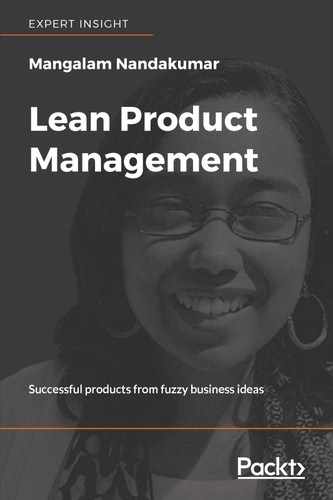Ideation is a wonderfully creative process that can help us to take leaps into solutions. When building products under ambiguous conditions, we don't know how customers will adopt our product, how to deliver the best experience, or even which problems are more important to solve. Ideas can help us to navigate ambiguity by throwing open possibilities that we couldn't see earlier. At the same time, ideas can distract us from our goals. Product managers must be able to take ideas in their stride and be able to differentiate between ideas that add value and those that sound important but create no value. However, this does not have to be an individual's judgment. This happens best when we collaborate with business functions and stakeholders to estimate the impact and ensure that we share the same definition of success. This chapter proposes a framework for evaluating the impact of ideas on Key Business Outcomes.
The framework will ensure that we carry over only the most impactful feature ideas into the product backlog. Our backlog can then be lean, and we can focus all our resources on delivering the most value both to the customer and to the business.
In this regard, this chapter addresses the following points, describing how to do these:
- Finding the right problem to solve
- Creating an end-to-end view of the user and business (product/service) interaction
- Identifying feature ideas
- Estimating impact on Key Business Outcomes and derive value scores
- Prioritizing feature ideas based on value scores
"An idea is like a virus. Resilient. Highly contagious. And even the smallest seed of an idea can grow. It can grow to define or destroy you."- Cobb, Inception
A friend recently observed that any conversation in Bengaluru (India) sooner or later steers toward traffic woes. Invariably, everyone claims to have a solution for Bengaluru's traffic woes. You get to hear all sorts of ideas: fix all the potholes, build flyovers, introduce more public transport, and get those hyperloops or even flying cars. There are so many ideas, but our traffic woes persist.
We are creatures of imagination and ideas. We love fantasy. We dream up a reality that doesn't exist today, but that is also our biggest strength. Ideas can motivate us to strive for the impossible, but that is also the bane of ideas. There is a very fuzzy line between difficult and impossible. We end up chasing our tails trying to pursue ideas that sound important. Why is that? Is it because we don't understand our problem well enough? If we don't know what problem we're solving, how can we find the right solution?
In many cases, the problem is ubiquitous, for instance, the Bengaluru traffic problem. You only need to drive on Bengaluru roads twice to come up with a laundry list of issues. The traffic problem is real, unique, and personal to each of us. So, of course, everyone has a solution. Just because everyone has an idea, it doesn't mean those solutions are viable and valuable. Some ideas just aren't practical. Some ideas need way more investment. Some ideas are culturally bound to fail and some won't even take off because of political or social reasons. Some ideas will take a really long time before they start making a difference. Meanwhile, we find our own little ways to circumvent the problem. We work from home, take the bus, drive in off-peak hours, carpool, work in shifts, move closer to workplaces, take de-stressing yoga classes, and so on.
When we know enough about the problem, it is more valuable, effective, and fun to ideate. People love to ideate even about seemingly hard-to-solve problems. Sometimes, viability or the lack of viability of a solution can help us understand the problem better. When operating under uncertainty (where we are yet to fully grasp the potential of the market or what our customers value), we need to make ideas our friends. Finding ideas for a product isn't the hardest part, because ideas come cheap. The hard part is always finding the idea that will deliver our unique value proposition and business outcomes. By the way, ideas often come disguised as implementation specifics. So, product management also has to deal with sorting out the "how" from the "what."

